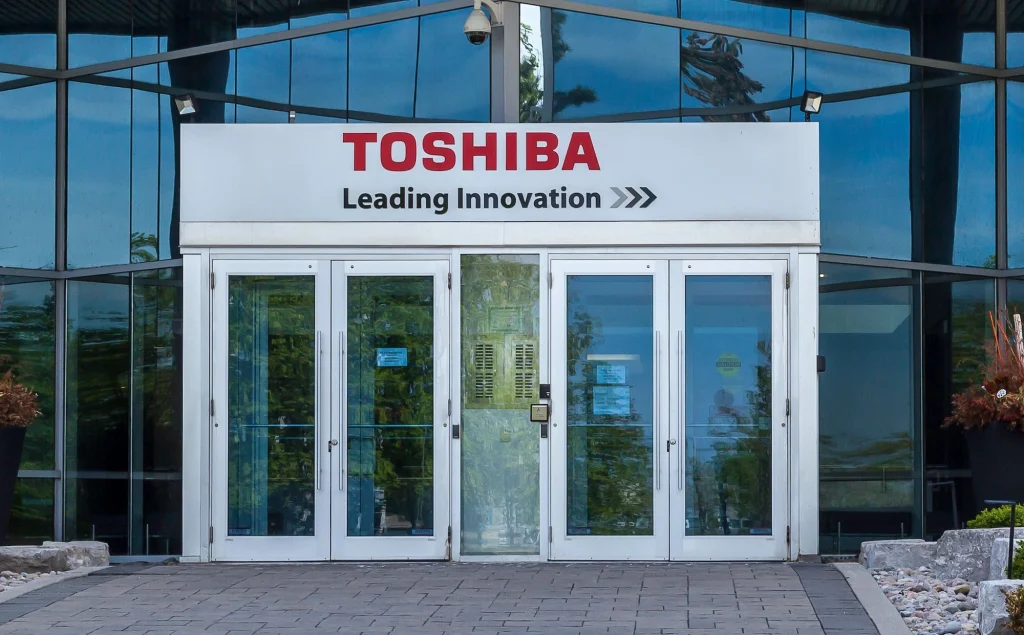Yevgeni Tsirulnik shares how Toshiba Global Commerce Solutions is creating AI-powered personalization, operational efficiency and seamless shopping experiences for small and mid-sized retailers
Artificial intelligence is helping to redefine the retail, fitness and wellness landscape, driving innovation that impacts both consumer experiences and business operations. But for small and mid-sized companies, embracing AI has historically felt out of reach due to resource constraints and technical barriers.
Yevgeni Tsirulnik, senior vice president of innovation, grocery, and general merchandising at Toshiba Global Commerce Solutions, spoke with Athletech News about how scalable edge-AI platforms and unified commerce backbones are leveling the playing field. By leveraging modular solutions, SMBs can unlock hyper-personalized engagements, optimize inventory and streamline operations — all without sacrificing the human connection central to their brand identity.
Tsirulnik explains how these AI advancements are enabling smaller players to implement cutting-edge technology at their own pace, empowering them to stay competitive while ensuring a touch of authenticity in every interaction.
Emerging AI Trends in Retail
Athletech News: What are some of the most significant AI trends you’re seeing in the retail sector today? How are these trends shaping consumer experiences and business operations for small and mid-sized retailers?
Yevgeni Tsirulnik: We’re seeing two clear shifts in AI trends for the retail industry. First is the rise of scalable edge-AI platforms. Overhead cameras, shelf sensors and smart cabinets now run computer vision models directly in the store. They follow traffic patterns, measure dwell time, update baskets and even decide when to unlock a product cabinet. This is all accomplished in real-time without sending video off-site or relying on cloud platforms. Because the platform is modular, retailers are empowered to rapidly update and refine their store technologies. Retailers can add extra AI compute boxes to help process data locally and make real-time decisions. They can host AI models that are trained on text data that can be used for product advice, or biometric sensors that can be registered in minutes and begin running AI for enhanced customer service or loyalty measures.
The second shift is having a unified commerce backbone. Every edge device, ranging from a kiosk, an electronic shelf label, or a camera, all share the same live services for customer profiles, loyalty, pricing and payments. Creating seamless experiences across digital and physical shopping journeys is critical. A promotion pushed in the app is honored in the store kiosk the moment a shopper picks up the product, or adding a new payment rail is a configuration change, instead of a full payment program rewrite.

Together, the edge platform and a unified backend let small and mid-size fitness or wellness retailers apply new AI solutions to address one pain point or new goal like scan-free checkout, smart shelving, or behavior observation, and build upon that system to grow into richer AI-powered experiences on their own timetable while keeping the hands-on service their customers expect.
Leveling the Playing Field for SMBs
ATN: AI is often associated with large enterprises due to resource availability. What steps can smaller retailers and brands take to incorporate AI into their operations without requiring extensive budgets or technical expertise?
YT: AI isn’t only for billion-dollar chains. A specialty store can start with a single edge device that plugs straight into its current network and commerce APIs. One example is installing a computer-vision camera mounted on a locked cabinet that runs an age-verification model, processes the request, and releases the latch all in real-time without the lag or dependency on the cloud. Another example is a weight-sensing shelf that flags missing inventory the moment a product is no longer detected on the shelf, then triggers an auto-reorder. Both devices register to the same edge platform, so adding a small AI compute box later lets retailers host an AI model that answers product questions right on the kiosk without any new servers or data-science hires.
The pathway to AI innovation is simple: choose a priority pain point to focus on, utilize hardware that self-registers with open APIs, and incrementally adopt and pay for each microservice as they are turned on. This ensures that retailers are growing capability instead of complexity over time.
Personalization & Customer Engagement
ATN: AI helps drive hyper-personalized experiences for customers. How can SMB retailers and brands use AI to tailor their marketing strategies, enhance customer engagement and optimize shopping experiences?
YT: Personalization starts with a single, living profile that follows a shopper across all touchpoints, ranging from a mobile app to a store or studio check-in, kiosk and even smart shelves. When a shopper profile sits on a unified commerce platform, edge devices continuously enrich it. A vision camera logs which shelf the customer lingered at, an AI-powered chatbot records supplement questions asked on the kiosk, and a trust engine notes whether a customer always picks up curbside orders on time. Those signals stream into a real-time promotion service that can do three things for an SMB:
Contextual offers in seconds: If a shopper scans a collagen powder, the engine can instantly bundle a vitamin discount at the kiosk.
Store-level nuance without store-level headaches: The same promotion rule can present a higher-protein upsell at the gym-adjacent branch, while the downtown spa promotes skincare. This maximizes opportunities with different data inputs from a single prompt.
Conversational guidance where it matters: AI models running on a palm-sized computing device let the kiosk answer, “Which pre-workout is vegan?” on the spot, using the customer’s loyalty tier and purchase history to rank responses.
Because everything is modular, an SMB can activate a real-time promotions micro-service first, add the in-aisle chatbot later and keep tuning rules with plain-language prompts. That keeps AI-driven engagement firmly in reach of teams that don’t have dedicated full-time data scientists but still want the one-to-one experience shoppers value.

Operational Efficiency & Cost Savings
ATN: Besides improving customer-facing interactions, AI has the potential to transform internal operations. How can SMBs leverage AI to streamline supply chain management, inventory tracking and other back-office functions?
YT: Retailers are using store-level AI to maximize store hours and eliminate waste from day-to-day operations. A fitness store can fit a vision camera above its loading dock: the model reads every pallet’s barcode and counts it as it rolls off the truck, flags short shipments on the spot and pushes clean data straight into a master inventory database. On the sales floor, weight pads placed under high-turn items feed real-time stock levels to a demand engine that is also being pushed by local weather and fitness class or wellness schedules. Based on that data, the system drafts the next order and pauses promos when supplies run thin, cutting both out-of-stocks and over-ordering.
The same edge platform hosts an AI model that reads supplier invoices, matches them to the dock log, codes them and posts them to the enterprise resource planning software in minutes instead of days. Another example is implementing a plug-in that listens to cooler compressors and predicts failures early enough to schedule service before product is lost. All of these initiatives just require modular devices that register themselves on the network and bill as a subscription. This eliminates the need for a data-science team or a new server room. Start with the dock, add the shelves, then layer on back-office AI applications, and retailers will start to see savings grow.
Balancing Human Touch With Automation
ATN: As SMBs implement AI, how can they strike a balance between AI-driven automation and maintaining a human touch in customer interactions to ensure brand authenticity and loyalty?
YT: Treat AI as a partner that handles the mechanics while people own the judgment calls. Vision models can unlock a supplement cabinet after an age-check, keep shelf inventory up to the minute and draft re-orders, all while logged in real-time and the option to be accessible on mobile devices like a tablet. When a shopper needs more in-depth service that is beyond a yes-or-no, “Which protein is best for marathon training?” the system routes them to an associate who already sees stock levels, purchase history and loyalty status to make a more informed and strategic interaction. That context lets humans give enhanced and tailored advice instead of scrambling for basic information.
Shoppers also set their own pace. If they just want to grab-and-go, AI powers a seamless and speedy self-checkout. If they press “Need Help” at the kiosk, a staff member arrives informed of what the customer lingered over and any questions the kiosk couldn’t answer. Behind the scenes, managers define the guardrails of what tasks AI can complete on its own, determine confidence thresholds for alerts and decide when a task is hands-off and strictly assigned to AI so associates can focus on other parts of the store. This ensures critical decisions and brand voice always stay human. AI automation lifts the routine load, and people use its fresh insights to deliver the informed empathy and expertise that keep customers loyal.
The Power of Toshiba Global Commerce Solutions
ATN: What are the solutions you offer retailers, and how would you describe the value proposition of your offerings? What differentiates it from others in the market?
YT: Toshiba Global Commerce Solutions is the only technology leader that specializes in every piece of the retail puzzle, offering wall-to-wall solutions ranging from software to hardware and services.
At the core is Elera, a micro-service commerce platform that unifies checkout, mobile, loss prevention, loyalty, inventory, payments and promotions under a single platform. Because each capability is modular, a specialty retailer can switch on only what solves today’s pain (scan-less checkout, real-time loyalty promotions, or even curbside fulfillment) and scale at their own pace.
The MxP Vision Kiosk is powered by AI-driven technology that transforms the checkout process into a fast, effortless experience through automatic product recognition and biometric payment options. Designed perfectly for space-constrained retailers desiring a smart and secure “grab and go” solution, the MxP Vision Kiosk makes the checkout experience simple and streamlined.
What sets us apart is the end-to-end ownership of both the edge hardware and the cloud software, delivered under one commerce platform and backed by retail-hardened services. Retailers start with the module that fits their unique needs, then scale at their own pace, all while keeping the human touch front and center as the technology handles the heavy lifting.


